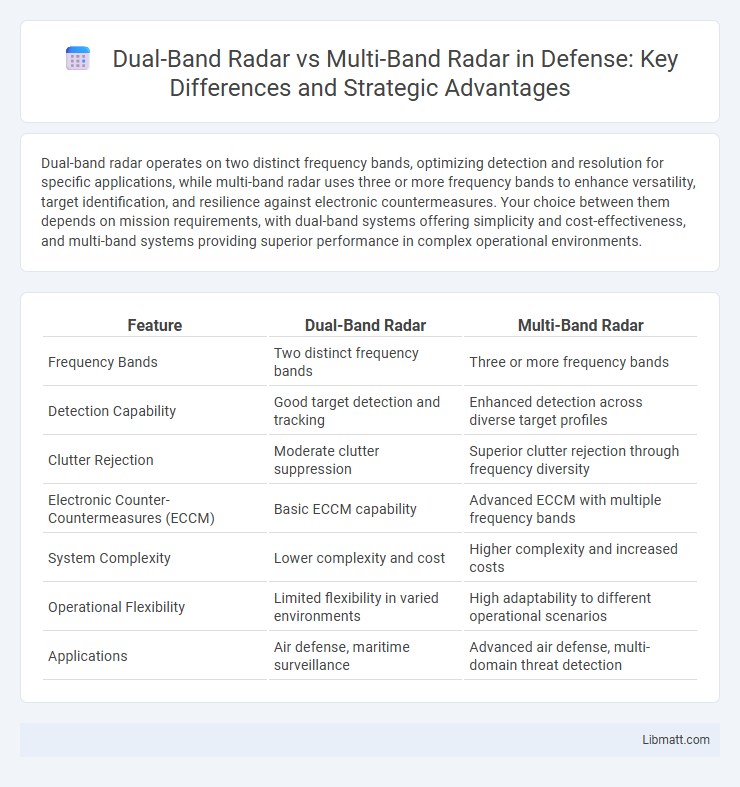Dual-band radar operates on two distinct frequency bands, optimizing detection and resolution for specific applications, while multi-band radar uses three or more frequency bands to enhance versatility, target identification, and resilience against electronic countermeasures. Your choice between them depends on mission requirements, with dual-band systems offering simplicity and cost-effectiveness, and multi-band systems providing superior performance in complex operational environments.
Table of Comparison
| Feature | Dual-Band Radar | Multi-Band Radar |
|---|---|---|
| Frequency Bands | Two distinct frequency bands | Three or more frequency bands |
| Detection Capability | Good target detection and tracking | Enhanced detection across diverse target profiles |
| Clutter Rejection | Moderate clutter suppression | Superior clutter rejection through frequency diversity |
| Electronic Counter-Countermeasures (ECCM) | Basic ECCM capability | Advanced ECCM with multiple frequency bands |
| System Complexity | Lower complexity and cost | Higher complexity and increased costs |
| Operational Flexibility | Limited flexibility in varied environments | High adaptability to different operational scenarios |
| Applications | Air defense, maritime surveillance | Advanced air defense, multi-domain threat detection |
Introduction to Radar Systems
Radar systems utilize electromagnetic waves to detect and locate objects by analyzing signal reflections. Dual-band radar operates using two distinct frequency bands, enhancing target detection and resolution in specific environments. Multi-band radar incorporates multiple frequency bands, offering greater versatility and improved performance across diverse conditions and target types.
What is Dual-Band Radar?
Dual-band radar operates by simultaneously using two distinct frequency bands to enhance target detection and resolution in various environmental conditions. Unlike single-band radar, it reduces signal interference and improves accuracy, making it ideal for applications such as weather monitoring, aviation safety, and autonomous vehicle navigation. Your choice of dual-band radar can optimize performance by leveraging complementary frequency bands tailored to specific sensing requirements.
What is Multi-Band Radar?
Multi-band radar operates across multiple frequency bands, offering enhanced detection, resolution, and target identification compared to dual-band radar, which typically uses only two frequency ranges. By leveraging several frequency bands, multi-band radar improves performance in complex environments through better clutter suppression and adaptability to varying operational conditions. Your surveillance or tracking system benefits from multi-band radar's versatility and increased accuracy in distinguishing diverse objects.
Key Differences: Dual-Band vs Multi-Band Radar
Dual-band radar operates on two distinct frequency bands, typically combining lower-frequency bands for long-range detection and higher-frequency bands for high-resolution imaging. Multi-band radar extends this concept by using three or more frequency bands, enhancing target detection accuracy, clutter suppression, and adaptability across diverse environments. The key differences lie in frequency diversity: dual-band radars offer balanced performance in specific scenarios, whereas multi-band radars provide superior versatility and robustness in complex operational contexts.
Frequency Ranges and Band Utilization
Dual-band radar systems typically operate within two distinct frequency ranges, often combining bands such as X-band and Ku-band to balance resolution and range performance. Multi-band radar extends this concept by utilizing three or more frequency bands, enhancing detection capabilities and target discrimination across a broader spectrum. Frequency range diversity in multi-band radars improves adaptability to various environmental conditions and countermeasure resilience, optimizing band utilization for complex operational scenarios.
Performance Comparison: Accuracy and Resolution
Dual-band radar systems typically operate on two distinct frequency bands, optimizing accuracy and resolution by balancing penetration and target discrimination in varied environments. Multi-band radar extends this capability further by utilizing three or more frequency bands, enhancing detection accuracy and spatial resolution through comprehensive spectral analysis and reduced interference. Consequently, multi-band radars deliver superior target identification and clearer imagery in complex scenarios compared to dual-band configurations.
Applications of Dual-Band Radar
Dual-band radar systems are widely used in aviation and weather monitoring for enhanced target detection and clutter suppression by operating on two distinct frequency bands. Your choice of dual-band radar improves accuracy in distinguishing between different object types, such as separating aircraft from weather phenomena. These radar systems excel in applications requiring reliable performance across varied environmental conditions and improved resolution without the complexity of multi-band configurations.
Applications of Multi-Band Radar
Multi-band radar systems are extensively used in advanced surveillance, weather monitoring, and military applications due to their ability to operate across multiple frequency bands for enhanced resolution and target detection. These systems enable improved penetration through various atmospheric conditions, making them ideal for tracking stealth aircraft and detecting diverse environmental phenomena simultaneously. Multi-band radars offer superior adaptability in electromagnetic spectrum utilization, ensuring optimal performance in complex scenarios such as battlefield reconnaissance and climate observation.
Advantages and Limitations of Each System
Dual-band radar offers improved target detection and classification by operating on two frequency bands, enhancing resolution and penetration through adverse weather conditions, but its limited frequency range may restrict versatility. Multi-band radar extends this capability by utilizing multiple frequency bands, providing superior adaptability and accuracy in diverse environments, though it often demands greater system complexity, cost, and power consumption. Your choice between dual-band and multi-band radar systems depends on the specific operational requirements, balancing performance benefits against practical constraints.
Future Trends in Radar Band Technology
Future trends in radar band technology emphasize the shift from dual-band radar systems, which operate on two frequency bands, to multi-band radar systems that utilize three or more bands for enhanced target detection and resolution. Multi-band radars offer greater adaptability and improved performance in cluttered environments by leveraging diverse frequencies to overcome atmospheric and material interference. Your choice of radar technology will increasingly depend on the need for higher accuracy, better stealth detection, and multi-functional capabilities in evolving applications such as autonomous vehicles and advanced defense systems.
dual-band radar vs multi-band radar Infographic

 libmatt.com
libmatt.com